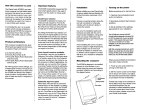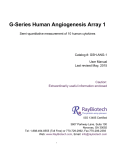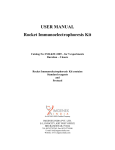Download Nuclear/Cytosolic Fractionation Kit
Transcript
Product Manual Nuclear/Cytosolic Fractionation Kit Catalog Number AKR-172 100 preps FOR RESEARCH USE ONLY Not for use in diagnostic procedures Introduction Cell Biolabs’ Nuclear/Cytosolic Fractionation Kit provides a simple and fast tool to isolate nuclear extract from the cytoplasmic fraction of mammalian cells. The procedure has been optimized to provide extraction, with high protein recovery and low cross-contamination, in less than 2 hours. The extracted protein fractions are functional and suitable for downstream assays such as DNA footprinting, RNA splicing, gel shift assays (EMSA), reporter assays, enzyme activity assays, and Western blotting. Each kit provides sufficient quantities to perform 100 preps (up to 5 x 106cells each). Related Products 1. AKR-102: Phospho Antibody Stripping Solution 2. AKR-103: PhosphoBlocker™ Blocking Reagent (1L) 3. AKR-105: Phosphoprotein Purification Kit Kit Components Box 1 (shipped at room temperature) 1. Cytosol Extraction Buffer, Hypotonic (10X) (Part No 217201): One bottle – 10 mL. 2. Cell Lysis Reagent (Part No. 217202): One bottle – 5 mL of 10% Igepal CA-630 in 1X Cytosol Extraction Buffer (CEB). 3. Nuclear Extraction Buffer (Part No. 217203): One bottle – 10 mL. Box 2 (shipped on blue ice packs) 1. Dithiothreitol (1000X) (Part No. 217204): One vial – 100 μL of 1 M DTT. 2. Protease Inhibitor Cocktail (100X) (Part No. 217205): One vial – 1 mL containing AEBSF, Aprotinin, Bestatin, E64, Leupeptin, and Pepstatin A in DMSO. Materials Not Supplied 1. PBS 2. Microcentrifuge tubes 3. Microcentrifuge Storage Upon receiving, aliquot and store Dithiothreitol and Protease Inhibitor Cocktail at -20ºC and avoid multiple freeze/thaw cycles. Store all other components at 4ºC. Preparation of Reagents 1X Cytosol Extraction Buffer (CEB): Dilute the 10X Cytosol Extraction Buffer to 1X with deionized water. Stir to homogeneity. 2 Dithiothreitol: Immediately before use dilute the Dithiothreitol 1:1000 with 1X Cytosol or Nuclear Extraction Buffer. Stir to homogeneity. Do not store diluted solutions. Protease Inhibitor Cocktail: Immediately before use dilute the Protease Inhibitor Cocktail 1:100 with 1X Cytosol or Nuclear Extraction Buffer. Stir to homogeneity. Do not store diluted solutions. Preparation of Samples I. Adherent Cells 1. Culture cells to approximately 80-90% confluence. 2. Aspirate the culture media and wash twice with PBS. 3. Detach the cells from the plates in PBS by scraping with a cell scraper. 4. Collect the solution into an appropriate conical centrifuge tube. 5. Centrifuge for 5 minutes (600 x g). 6. Discard the supernatant and immediately proceed to the Assay Protocol Section. II. Suspension Cells 1. Collect the cells into an appropriate conical centrifuge tube. 2. Centrifuge for 5 minutes (600 x g). 3. Remove and discard the supernatant. 4. Wash the cells twice with PBS. 5. Centrifuge for 5 minutes at (600 x g). 6. Discard the supernatant and immediately proceed to the Assay Protocol Section. Assay Protocol Important Note: Perform the below steps at 2-8ºC. All buffers, centrifuge rotors, and equipment should be maintained at 2-8ºC. Before use, Dithiothreitol and Protease Inhibitor Cocktail should be diluted according to the Preparation of Reagents section above. I. Cytosol Fractionation Protocol 1. Collect cells (up to 5 x 106) by centrifugation for 5 minutes at 4ºC (600 x g). 2. Wash the cells once with ice cold PBS. 3. Remove and discard the supernatant. 4. Gently resuspend the cell pellet with 500 µL of ice cold, 1X Cytosol Extraction Buffer (containing DTT/Protease Inhibitors) by pipetting up and down. 5. Transfer the suspension into a prechilled microcentrifuge tube. 6. Incubate on ice for 10 minutes. 3 7. Add 25 µL of Cell Lysis Reagent and vortex for 10 seconds at the highest setting. 8. Centrifuge for 10 minutes at 4ºC (800 x g). 9. Carefully transfer the supernatant (cytoplasmic fraction) to a clean, chilled microcentrifuge tube. The cytoplasmic fraction can be stored at -80ºC for future use. Note: Make sure not to disturb/remove the nuclei pellet. 10. Gently resuspend the pellet with 500 µL of ice cold, 1X Cytosol Extraction Buffer (containing DTT/Protease Inhibitors) by pipetting up and down. Note: This wash step is included to reduce cross-contamination between fractions. 11. Add 25 µL of Cell Lysis Reagent and vortex for 10 seconds at the highest setting. 12. Centrifuge for 10 minutes at 4ºC (800 x g). 13. Carefully aspirate the supernatant and discard of this wash. II. Nuclear Protein Extraction Protocol 1. Gently resuspend the nuclear pellet with 100 µL of ice cold, 1X Nuclear Extraction Buffer (containing DTT/Protease Inhibitors) by pipetting up and down. 2. Maintain on ice for 30 minutes, vortexing for 10 seconds at the highest setting in 10 minute intervals. 3. Centrifuge for 30 minutes at 4ºC (14000 x g). 4. Carefully transfer the supernatant (nuclear protein extract) to a clean, chilled microcentrifuge tube. The extract can be stored at -80ºC for future use. Note: The nuclear extract typically yields protein concentrations of > 1 mg/mL. If greater concentrations are desired, resuspend the nuclear pellet in a smaller volume in step 1 above (minimum of 25 µL). III. Other Considerations For determining the protein content of extracts, samples must be diluted 1:2 before running in the Bradford Protein Assay. Buffer only controls must be performed concurrently. DTT in the buffers is not compatible with the BCA Protein Assay. Nuclear Extraction Buffer is a high salt buffer, containing 420 mM NaCl. If salt removal is necessary, dialysis or a desalting column may be used. 4 Example of Results The following figure demonstrates typical results seen with Cell Biolabs’ Nuclear/Cytosolic Fractionation Kit. One should use the data below for reference only. Figure 1: HEK293 Cell Fractionation. Cytosolic and nuclear protein extracts were isolated from Human Embryonic Kidney 293 cells according to the Assay Protocol. Whole cell (W), cytosol (C), and nuclear (N) fractions were immunoblotted with Anti-α-Tubulin (left) or Anti-Lamin A/C (right) at 1 µg/mL. Note: Anti-α-Tubulin (Calbiochem CP06) and Anti-Lamin A/C (Sigma SAB4200236) are both mouse monoclonals. Tubulin and Lamin are known to be cytosolic and nuclear specific proteins, respectively. Figure 2: HEK293 Trypan Blue Staining. Human Embryonic Kidney 293 cells were stained with Trypan Blue at various steps during the fractionation protocol, demonstrating complete lysis and high neuclei recovery. Recent Product Citations 1. Nakamura, S. et al. (2015). Novel roles for LIX1L in promoting cancer cell proliferation through ROS1-mediated LIX1L phosphorylation. Sci Rep. doi:10.1038/srep13474. 5 2. Shinmura, K. et al. (2015). NEIL1 p. Gln282Stop variant is predominantly localized in the cytoplasm and exhibits reduced activity in suppressing mutations. Gene. doi:10.1016/j.gene.2015.06.043. 3. Jeon, Y. J. et al. (2015). A set of NF-κB–regulated microRNAs induces acquired TRAIL resistance in lung cancer. Proc Natl Acad Sci U S A. 112:E3355-64. 4. Ohtsuka, S. et al. (2014). SQSTM1/p62/A170 regulates the severity of Legionella pneumophila pneumonia by modulating inflammasome activity. Eur J Immunol. 44:1084-1092. 5. Zou, J. et al. (2014). A TIR domain protein from E. faecalis attenuates MyD88-mediated signaling and NF-κB activation. PLoS One. 9:e112010. Warranty These products are warranted to perform as described in their labeling and in Cell Biolabs literature when used in accordance with their instructions. THERE ARE NO WARRANTIES THAT EXTEND BEYOND THIS EXPRESSED WARRANTY AND CELL BIOLABS DISCLAIMS ANY IMPLIED WARRANTY OF MERCHANTABILITY OR WARRANTY OF FITNESS FOR PARTICULAR PURPOSE. CELL BIOLABS’ sole obligation and purchaser’s exclusive remedy for breach of this warranty shall be, at the option of CELL BIOLABS, to repair or replace the products. In no event shall CELL BIOLABS be liable for any proximate, incidental or consequential damages in connection with the products. Contact Information Cell Biolabs, Inc. 7758 Arjons Drive San Diego, CA 92126 Worldwide: +1 858-271-6500 USA Toll-Free: 1-888-CBL-0505 E-mail: [email protected] www.cellbiolabs.com 2012-2015: Cell Biolabs, Inc. - All rights reserved. No part of these works may be reproduced in any form without permissions in writing. 6












![Estrogen Receptor (ER) [SP1]](http://vs1.manualzilla.com/store/data/005885543_1-e9d75303a2a759dcb2dd4dad516aa5ce-150x150.png)
